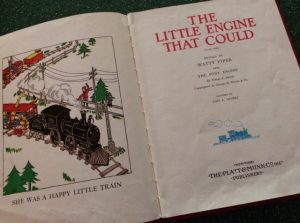On my recent visit to Kuwait, a smiling woman named Alaa Alothman came up to me while I was autographing books and asked something that stopped me in my tracks.
“You say that many books have influenced you throughout your life,” she began, “so I am curious what children’s book had an impact on you?”
I looked up and just stared at her.
“What a truly great question,” I announced. “I’ve never been asked that before.”
I hadn’t, either.
I went on to tell her that I’d have to think about it, as it was something I never considered.
It truly made me think.
After all, what children’s book did I read almost 60 years ago?
We talked for a few moments while my mind searched my memory banks for an answer.
And then it dawned on me.
“You know, it may sound simple, but I think The Little Engine that Could was probably the first book that inspired me as a child. I vaguely remember my mother reading it to me in the 1950s.”
Alaa smiled big, nodding her recognition of the famous book.
“The book was about an engine and my father worked on the railroad,” I said. “And the message was about believing in yourself, which I soaked up. It was probably the first self-help book I ever discovered.”
After the event in Kuwait, I became curious about the famous children’s book.
Turns out the story of the positive self-talking little engine goes back to at least 1906.
The first known use of the story is attributed to Rev. Charles S. Wing, who probably didn’t originate the story but delivered it to his congregation in Brooklyn in 1906.
It went like this:
In a certain railroad yard there stood an ex tremely heavy train that had to be drawn up an unusually heavy grade before it could reach its destination. The superintendent of the yard was not sure what it was best for him to do, so he went up to a large, strong engine and asked :
“Can you pull that train over the hill?”
“It is a very heavy train,” responded the en gine.
He then went to another great engine and asked:
“Can you pull that train over the hill?”
“It is a very heavy grade,” it replied.
The superintendent was much puzzled, but he turned to still another engine that was spick and span new, and he asked it:
“Can you pull that train over the hill?”
“I think I can,” responded the engine.
So the order was circulated, and the engine was started back so that it might be coupled with the train, and as it went along the rails it kept repeating to itself: “I think I can. I think I can. I think I can.”
The coupling was made and the engine began its journey, and all along the level, as it rolled toward the ascent, it kept repeating to itself: “I —think —I can. I —think —I— can. I —think— I —can.”
Then it reached the grade, but its voice could still be heard: “I think I can. I—– think—–I—–can. I —–think—– I—– can.”
Higher and higher it climbed, and its voice grew fainter and its words came slower:
“I ——-think ——–I——-can.”
It was almost to the top.
“I ———think”
It was at the top.
“I ———can.”
It passed over the top of the hill and began crawling down the opposite slope.
‘I ——think——- I—— can——I—– thought——I——-could I—– thought—– could. I thought I could. I thought I could. I thought I could.”
And singing its triumph, it rushed on down toward the valley.
But the best known version of the story is the book, The Little Engine that Could, published in 1930 and attributed to Watty Piper, the pen name of the publisher, Arnold Munk.
No one knows with any agreed certainty who actually originated the story.
That little story about “I think I can…I think I can…” influenced many, including me.
What children’s book influenced you?
Ao Akua,
joe
PS –My new book, The Secret Prayer, will be available soon. You can hear the actual prayer online, for free, by clicking right here.




7 Comments
I have recently dragged books I wrote 1 years ago out of storage and am in the process of illustrating and self publishing them…hoping one of them can influence someone who needs it!!~tess
I’m not sure what I learned from it, or why it inspired me, but the children’s book that has stuck with me some 50 years is “Mr. Blue” by Margaret Embry. It’s the story of a stray cat, alleged in the book to be Siamese (but clearly it’s a Russian Blue), who persists in charming his way into the hearts and classroom of elementary kids, teaching compassion and faith along the way. Of course, the cat “talks”, or seems to.
Maybe it was the idea of a smart, talking cat; maybe it was the persistence of the cat, whose entire attitude was one of assumption. He just assumed they’d let him in, assumed they’d allow him free rein in the classroom, assumed they would all love him–and they did. That sort of assumption is the foundation of the law of attraction, isn’t it?
Thank you for this beautiful story. I, too remember that little book. I’m sure it has been a subtle theme running in the back of my mind. I enjoyed reading it again.
Wonderful blog Joe, I remember my mother reading me that book and how excited I would get at the continuing rhythm as the train keeper believing in himself and overcoming what others thought was impossible.
For me the most influential book was The Giving Tree written and illustrated by Shel Silverstein.
The book follows the life of a female [apple] tree and a boy who are able to communicate with each other; the tree addresses the human as “Boy” his entire life. In his childhood, the boy enjoys playing with the tree, climbing her trunk, swinging from her branches, and eating her apples. However, as time passes he starts to make requests of the tree.
After entering adolescence, the boy wants money; the tree suggests that he pick and sell her apples, which he does. After reaching adulthood, the boy wants a house; the tree suggests he cut her branches to build a house, which he does. After reaching middle age, the boy wants a boat; the tree suggests he cut her trunk to make a boat, which he does, leaving only a stump. Each such stage of giving by the tree ends with the sentence “And the tree was happy.”
In the final pages, the boy (now a shriveled old man) meets the tree once more. The tree sadly states she has nothing left to give, as her apples, branches, and trunk are gone and only a stump remains. But the boy wants only “a quiet place to sit and rest,” which the stump can provide. This final stage of giving, and the entire story, end with the sentence “And the tree was happy.”
I still have my original copy from childhood and am overwhelmed with emotion when I look at just the cover of it. 🙂
It is a nice story. Many research suggest that we are the most influenced by the childhood. In my country, Czech rep., we didn’t have this book about little engine, but it reminded my of a serie of children’s fairytales about locomotives and bad wizzard.
The sorcerer used to be a normal man who was taken so much by his goal (to create the biggest locomotive) which he couldn’t achieve that he slowly turned to the dark side. Fortunately there was a child which was not scared of the magician and understood that he has good heart and that he’s not evil in nature. This child created for him a job in a locomotive model shop where he could create all his huge ideas and sell them to children as a toys.
I really like the moral of the story that no matter how evil a person may seem it is just his experience from the past which makes him bad. There’s always chance if you’re not scared to try.